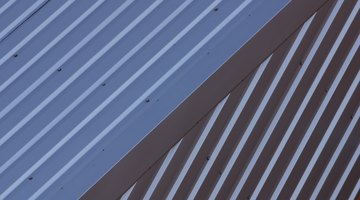5V Metal Roof Vs. Standing Seam
Metal roofing comes in a variety of different types, shapes and sizes. Two of the similar types of metal roofs that provide a durable and economical solution for many people's roofing needs include the standing seam and 5V-crimp metal roofing.

Each type of roof has its own features to meet the needs of homeowners and those involved in other construction projects.
Fasteners
One of the primary differences between the 5V-crimp metal roof panel and the standing seam roofing panel is the way in which each is fastened to other panels. Standing seam roofs are typically secured in place by concealed fasteners. These, along with clips that hold the roof in place, allow the metal roof to expand and contract as needed. With the 5V-crimp metal roof, the fasteners are exposed and do not provide this same allowance for contraction and expansion.
Appearance
Of the two, standing seam metal roofing has a higher profile. This means that its ribs will stick out farther and will be more visible, even to the casual passerby. The 5V-crimp metal roof has a lower profile and only has ribs that that appear at the seams. These ribs are smaller by comparison and help conceal the fact that the observer is looking at a metal roof. If you want all of the benefits of a metal roof, but don't want to necessarily have the obvious appearance of a metal roof, then the 5V roof is a better option.
Cost
When it comes to cost, you can generally expect to pay more for a standing seam system. However, there are other considerations that should also factor into the decision-making process that can affect the cost of the product you are buying. For instance, products with longer and more comprehensive warranties will also cost more as will those that have been painted and treated with special reflective and protective coatings.
Similarities
Despite the differences between the two types of metal roofs, a number of similarities exist also. For instance, both can be used equally as well in both residential and agricultural applications because of their strength and durability. Both generally come in a variety of colors and finishes that strengthen their durability. With the proper coating and underlayment, both can be energy efficient as well and help insulate the home from the elements.
References
Writer Bio
Jared Lewis is a professor of history, philosophy and the humanities. He has taught various courses in these fields since 2001. A former licensed financial adviser, he now works as a writer and has published numerous articles on education and business. He holds a bachelor's degree in history, a master's degree in theology and has completed doctoral work in American history.
Photo Credits
- Hemera Technologies/AbleStock.com/Getty Images
- Hemera Technologies/AbleStock.com/Getty Images
More Articles



